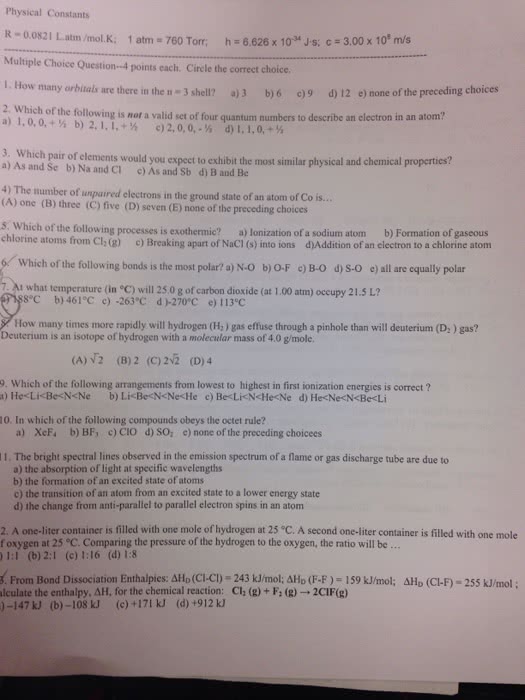CHEM-C 117 Midterm: C117 Exam 2 Study Guide (Mar. 2)
177 views8 pages
Document Summary
9-10 additional examples and information/study guide for exam 2. Bond energy- energy needed to break bond (endothermic: = (cid:1828)(cid:4666)(cid:1854)(cid:1867)(cid:1866)(cid:1856)(cid:1871) (cid:1854)(cid:1870)(cid:1867)(cid:1863)(cid:1857)(cid:1866)(cid:4667) (cid:1828)(cid:4666)(cid:1854)(cid:1867)(cid:1866)(cid:1856)(cid:1871) (cid:1858)(cid:1867)(cid:1870)(cid:1865)(cid:1857)(cid:1856)(cid:4667) Subtracting products accounts for exothermic bond formation. Pay attention to number of bonds and moles of each item. Bond h and cl (formed bond energy) Use bond energies to calculate the enthalpy change for h2(g) + f2(g) 2hf(g). dashes in parentheses are bond lines, 544 kj released for every mole of this reaction: ex. Draw lewis structures to see all bonds (esp. if bond types not given) 42 kj released for every mole of this reaction. Sodium must lose an electron (first ionization energy) Chlorine must gain an electron (electron affinity) Sodium is a solid, chlorine is a gas. Sodium must be converted to a gas (not really happening, but you need the energy required to do so to split sodium atoms up from a solid- heat of sublimation)
Get access
Grade+20% off
$8 USD/m$10 USD/m
Billed $96 USD annually

Homework Help
Study Guides
Textbook Solutions
Class Notes
Textbook Notes
Booster Class
40 Verified Answers
Related textbook solutions
Chemistry: Structure and Properties
2 Edition,
Tro
ISBN: 9780134293936
Basic Chemistry
5 Edition,
Timberlake
ISBN: 9780134138046
Principles of Chemistry Molecular Approach
4th Edition,
Tro
ISBN: 9780134112831
Chemistry: Structure and Properties
2nd Edition,
Tro
ISBN: 9780134293936
Principles of Chemistry Molecular Approach
3rd Edition, 2014
Tro
ISBN: 9780321971944
Chemistry: A Molecular Approach
3rd Edition,
Tro
ISBN: 9780321809247
Chemistry: A Molecular Approach
5th Edition,
Tro
ISBN: 9780134874371
Principles of Chemistry: A Molecular Approach
4th Edition,
Tro
ISBN: 9780134895741
Chemistry: The Central Science
14th Edition, 2017
Brown
ISBN: 9780134414232



